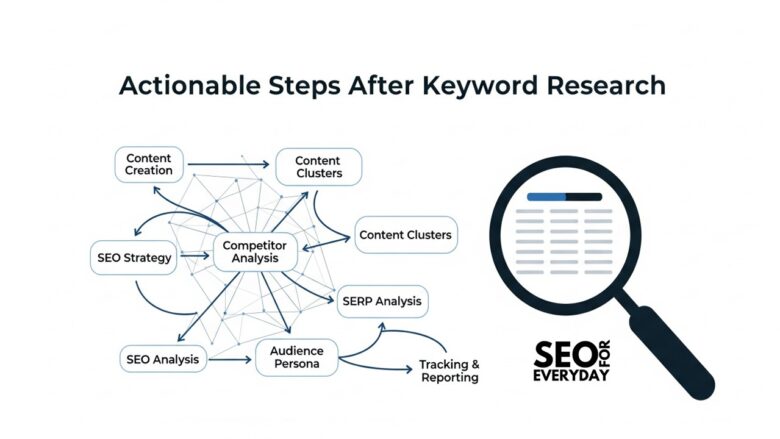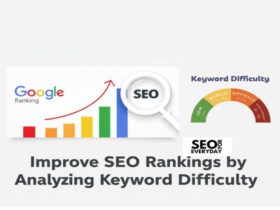So, you’ve done your keyword research—excellent! But here’s the truth: keyword research is the first step of your SEO journey. Many people stop there, wondering why their content doesn’t rank. The reality is, the magic happens in what you do after keyword research. This guide will teach you how to turn your keyword data into traffic, leads, and conversions.
Understanding the Value of Your Keywords
Analysing Search Intent
Not all keywords are equal. Some show that people are ready to buy (“best laptop under $1000”), while others show curiosity (“what is a laptop”). Understanding whether a keyword is informational, navigational, or transactional helps you craft content that meets user intent.
Categorising Keywords by Funnel Stage
- Top of Funnel (TOFU): Informational keywords, blogs, guides.
- Middle of Funnel (MOFU): Comparison keywords, case studies.
- Bottom of Funnel (BOFU): Product-focused, ready-to-buy searches.
Prioritising Based on Difficulty and Opportunity
Targeting a mix of high-volume, high-competition keywords and long-tail, low-competition ones create a balanced strategy. Think of it as building both short-term wins and long-term assets.
Organising Your Keywords
Creating Keyword Clusters
Instead of treating each keyword as an island, group related terms together. This makes your content more comprehensive and boosts topical authority.
Building Topic Silos
Silos help structure your site logically. For example, if your niche is fitness, one silo might be “weight loss,” with supporting content on diets, exercises, and supplements.
Mapping Keywords to Content Types
Each keyword has a best-fit format—some work for blog posts, others for landing pages, product descriptions, or FAQs.
Content Strategy Development
Identifying Content Gaps
Look at what competitors rank for that you don’t. That’s your opportunity to fill the gaps.
Matching Keywords with Blog Posts, Landing Pages, and Product Pages
Not every keyword belongs in a blog post. Some may be perfect for sales pages, category pages, or even video scripts.
Building a Content Calendar
Consistency is key. Plan weekly or monthly content around your keyword clusters to ensure steady growth.
On-Page SEO Optimization
Writing SEO-Friendly Titles and Meta Descriptions
Include your primary keyword, but keep it catchy. Your title is your first impression on search results.
Optimising Headers and Subheaders
Break down your content logically. Use H2S, H3S, and H4S to guide readers and search engines.
Using Keywords Naturally in Body Content
Gone are the days of keyword stuffing. Focus on readability and sprinkle keywords where they make sense.
Internal Linking Strategies
Link related pages together. This not only improves SEO but also keeps users on your site longer.
Technical SEO Considerations
Site Speed and Mobile Optimization
Even the best keywords won’t save you if your site is slow or not mobile-friendly.
Crawlability and Indexing
Make sure search engines can easily crawl and index your site. Use tools like Screaming Frog or Search Console to spot issues.
Structured Data for Better Visibility
Rich snippets can boost your CTR. Schema markup helps search engines understand your content better.
Content Creation Best Practices
Writing for Humans First, Search Engines Second
Yes, keywords matter, but engaging content that solves problems will always win.
Incorporating Multimedia
Images, videos, and infographics improve SEO and make your content more engaging.
Maintaining Readability and Engagement
Short paragraphs, bullet points, and a conversational tone make your content easy to digest.
Promotion and Distribution
Sharing Content on Social Media
Don’t just publish and pray. Share your content across platforms like LinkedIn, Twitter, and Facebook.
Email Marketing Strategies
Your email list is gold. Send new content to subscribers to boost traffic instantly.
Collaborations and Guest Posts
Partner with influencers or write guest posts on authority sites to reach a wider audience.
Tracking and Measuring Performance
Setting Up Google Analytics and Search Console
These tools give insights into your keywords’ performance and where improvements are needed.
Monitoring Keyword Rankings
Track your target keywords regularly. Tools like Ahrefs, SEMrush, or Ubersuggest can help.
Tracking Traffic, Conversions, and Engagement
It’s not just about ranking—it’s about business results. Monitor bounce rates, time on site, and conversions.
Updating and Refreshing Content
Identifying Outdated Content
Content can go stale. Regularly audit your site to see what needs updating.
Optimising Existing Articles for New Keywords
A quick update with fresh data and keywords can revive old articles.
Republishing and Promoting Updated Content
Don’t be afraid to re-share old but refreshed content across channels.
Scaling Your SEO Strategy
Expanding Into New Keyword Opportunities
As your site grows, target more competitive keywords and new topics.
Using Automation Tools
Leverage AI and SEO tools to speed up research, tracking, and optimization.
Building Long-Term Authority
Consistency, backlinks, and high-quality content build domain authority over time.
Keyword research is the foundation, but what you do afterwards determines your SEO success. From organizing keywords into clusters, developing content strategies, optimizing on-page SEO, to promoting and tracking results, you need a holistic approach. Think of keyword research as planting seeds; the real growth comes with nurturing, optimizing, and scaling over time.
Frequently Asked Questions
Start by analyzing search intent and grouping keywords into clusters to guide your content strategy.
Review it quarterly, but stay flexible for industry trends and Google updates.
A mix works best—low competition for quick wins, high volume for long-term growth.
Track rankings, traffic, and conversions using tools like Google Analytics and Search Console.
SEMrush, Ahrefs, Ubersuggest, and Google Sheets can help you organize your strategy.








1 Comment